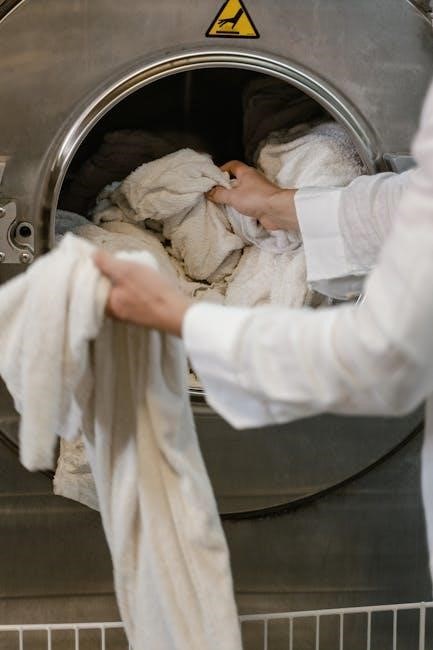
Troubleshooting your Amana dryer can save time and money․ This guide helps identify common issues like no heat, noise, or poor drying performance․ Follow step-by-step solutions to diagnose and fix problems safely and effectively at home․

Common Issues with Amana Dryers
Amana dryers are reliable but can experience issues like not starting, no heat, excessive noise, or poor drying performance․ These problems often stem from faulty components or maintenance oversights, which this guide will help identify and resolve․

2․1․ Dryer Not Starting
If your Amana dryer won’t start, begin by checking the power supply․ Ensure it’s properly plugged in and that the circuit breaker or fuse hasn’t tripped․ Next, verify the door switch is functioning, as an open door can prevent the dryer from running․ Check the thermal fuse, which may have blown due to overheating, and replace it if necessary․ If these steps don’t resolve the issue, inspect the electronic control board or power supply board for faults․ A faulty start switch or worn-out belt could also be the culprit․ Always consult your user manual for specific diagnostic guidance, and consider professional assistance if the problem persists․
- Check power supply and circuit breaker․
- Inspect door switch functionality․
- Test and replace the thermal fuse if needed․
- Examine control boards and belts for damage․
Addressing these potential causes can help restore your dryer’s operation efficiently․
2․2․ Dryer Not Heating
If your Amana dryer is running but not producing heat, several factors could be at play․ First, ensure the temperature settings are correctly selected, as using the wrong cycle can prevent heating․ Check the power supply to confirm it’s receiving the correct voltage․ A blown thermal fuse, often tripped due to overheating, is a common issue and may need replacement․ Inspect the heating element for damage or wear, as it may require professional servicing․ Additionally, a clogged vent or lint filter can restrict airflow, causing the dryer to stop heating․ Regularly cleaning the lint screen and exhaust vent is essential to maintain proper function․ If the issue persists, consult a technician to diagnose potential electrical or component failures, ensuring your dryer operates safely and efficiently․
- Verify temperature settings are correct․
- Check the thermal fuse and heating element․
- Inspect and clean the vent system․
- Ensure proper airflow for optimal performance․
Addressing these issues can restore heat to your Amana dryer effectively․
2․3․ Excessive Noise
Excessive noise from your Amana dryer can be both annoying and concerning․ To address this issue, start by ensuring the dryer is level on the floor, as an uneven surface can cause vibrations and loud operation․ Check the drum rollers for wear or damage, as they support the drum during rotation and may rattle if compromised․ Additionally, inspect the drive belt for signs of wear or misalignment, which can lead to slipping and noise․ The idler pulley, which guides the belt, should also be examined for smooth operation․ If the blower wheel is clogged with lint or debris, it may contribute to unusual sounds․ Regularly cleaning the lint filter and exhaust vent can improve airflow and reduce noise․ If the issue persists, consider consulting a professional to inspect internal components like the motor or bearings․ Addressing these potential causes can help restore quiet operation to your Amana dryer․
- Check and adjust the dryer’s leveling to prevent vibrations․
- Inspect drum rollers for wear and ensure proper function․
- Examine the drive belt for signs of wear or misalignment․
- Clean the blower wheel and ensure proper airflow․
- Consult a professional if internal components are suspect․
By addressing these factors, you can reduce excessive noise and ensure your dryer operates smoothly․

2․4․ Dryer Not Drying Clothes Properly
If your Amana dryer is not drying clothes properly, several factors could be at play․ A clogged lint filter or blocked exhaust vent can restrict airflow, leading to inefficient drying․ Regularly cleaning the lint filter and inspecting the venting system can help resolve this issue․ Additionally, overloading the dryer can prevent clothes from drying evenly, as overcrowding reduces airflow and heat distribution․ Ensuring proper load sizes and using the correct cycle settings for the fabric type can improve drying performance․ Faulty heating elements or a malfunctioning thermal fuse may also cause the dryer to underperform․ Check the heating element for continuity and ensure the thermal fuse has not blown․ If the issue persists, inspect the moisture-sensing sensors, as they may not be functioning correctly․ Addressing these potential causes can help restore your dryer’s ability to dry clothes efficiently and safely․
- Check and clean the lint filter and exhaust vent for blockages․
- Avoid overloading the dryer to ensure proper airflow and heat distribution․
- Verify the heating element and thermal fuse for proper function․
- Inspect moisture-sensing sensors for accurate operation․

By addressing these issues, you can optimize your dryer’s performance and ensure clothes dry thoroughly․

Advanced Troubleshooting Techniques
Advanced troubleshooting involves using specialized tools like multimeters for electrical diagnostics and inspecting internal components․ Understanding the electrical system and component-specific diagnostics can help identify complex issues, ensuring precise repairs and optimal dryer performance․
3․1․ Using a Multimeter for Electrical Diagnostics
A multimeter is an essential tool for advanced troubleshooting of your Amana dryer․ It allows you to measure electrical current, voltage, and resistance, helping identify issues in circuits and components․ Start by ensuring the dryer is unplugged from the power source for safety․ Set the multimeter to the appropriate function (voltage, current, or resistance) based on the component being tested․ For example, check the heating element for continuity by placing the probes on its terminals․ A reading of zero ohms indicates it’s functioning properly, while infinite resistance suggests a fault․ Similarly, test the thermal fuse by verifying its continuity․ If the multimeter detects no continuity, the fuse may need replacement․ Regularly using a multimeter can help pinpoint electrical malfunctions, ensuring precise repairs and preventing further damage․ This method is especially useful for diagnosing complex issues like faulty thermostats or failed sensors, making it a valuable skill for DIY repairs․
3․2․ Inspecting Internal Components
Inspecting internal components is crucial for diagnosing deeper issues in your Amana dryer․ Always unplug the dryer before accessing internal parts to ensure safety․ Start by removing the back panel to access the heating element, thermal fuse, and wiring․ Check for signs of wear, such as frayed wires or broken connections, which can cause electrical malfunctions․ Inspect the drum rollers and idler pulley for wear, as these can lead to excessive noise or vibrations․ The belt should be checked for cracks or looseness, as a faulty belt can prevent the drum from spinning․ Additionally, examine the moisture sensors and igniter (if applicable) for dirt or damage․ Use a multimeter to test the continuity of components like the thermostat or high-limit switch․ If any part is damaged or malfunctioning, replace it promptly to restore functionality․ Regular internal inspections can prevent minor issues from escalating into major repairs, ensuring your dryer operates efficiently and safely for years to come․

3․3․ Checking the Thermal Fuse

The thermal fuse is a critical safety component in your Amana dryer, designed to prevent overheating by interrupting power to the heating element․ Located near the heating element or on the dryer’s back, it trips if the dryer overheats․ To inspect it, unplug the dryer and access the fuse by removing the back panel․ Use a multimeter to test for continuity; if no reading is detected, the fuse is blown and needs replacement․ Ensure the dryer is cool before starting, as the fuse may reset temporarily if not entirely damaged․ A blown thermal fuse often indicates a blocked vent, faulty heating element, or excessive lint buildup․ Always replace it with the correct part to avoid further issues․ If unsure, consult a professional to ensure proper diagnosis and repair․ Regular checks can help prevent overheating and extend your dryer’s lifespan․ This step is essential for addressing heat-related problems and ensuring safe operation․
3․4․ Testing the Heating Element
Testing the heating element is crucial when diagnosing heating issues in your Amana dryer․ Start by unplugging the dryer and accessing the heating element, usually located near the rear․ Use a multimeter to measure resistance across the element’s terminals․ A reading within the manufacturer’s specifications indicates it’s functional․ If the multimeter shows no continuity or an unusually high resistance, the heating element may be faulty and require replacement․ Additionally, inspect the element for visible damage, such as cracks or burn marks, which can cause inefficiency or failure․ Before testing, ensure the dryer is cool to avoid inaccurate readings․ If the heating element is damaged, replacing it promptly prevents further issues and restores proper heating function․ Always follow safety guidelines when working with electrical components, and consult a professional if you’re unsure․ Regular inspections can help maintain your dryer’s performance and avoid costly repairs down the line․ This step is vital for troubleshooting heating-related problems effectively․

Preventive Maintenance Tips
Regular maintenance ensures your Amana dryer runs efficiently and prevents common issues․ Clean the lint filter after each use, inspect vents for blockages, and ensure proper loading․ Lubricate moving parts and schedule annual professional inspections to maintain optimal performance and extend the dryer’s lifespan․
4․1․ Cleaning the Lint Filter and Vent
Cleaning the lint filter and vent is essential for maintaining your Amana dryer’s efficiency and safety․ The lint filter should be cleaned after every use to ensure proper airflow and prevent fires․ To clean it, simply pull it out, wipe off accumulated lint with your hands or a soft brush, and reinstall it․ For the vent, inspect it regularly for blockages caused by lint buildup․ Use a dryer vent cleaning kit or a vacuum hose to remove debris from the venting system․ This will improve drying performance, reduce energy consumption, and lower the risk of overheating․ Additionally, check the exterior vent cover to ensure it opens properly during operation․ Cleaning these components regularly not only prolongs the dryer’s lifespan but also enhances its overall performance․ Make this a routine part of your maintenance to keep your Amana dryer running smoothly and safely․
4․2․ Checking for Blockages
Regularly checking for blockages is crucial for ensuring your Amana dryer operates efficiently and safely․ Start by inspecting the dryer vent and hose for lint buildup or kinks, as these can restrict airflow and cause poor drying performance․ Use a dryer brush or vacuum cleaner to remove lint and debris from the venting system․ Additionally, check the flexible duct connecting the dryer to the vent for any bends or compression that could obstruct airflow․ Clearing these blockages will improve drying times, reduce energy consumption, and prevent overheating․ It’s also important to ensure the vent hood on the exterior of your home opens and closes properly to allow moisture and lint to escape․ Regularly inspecting and cleaning these areas will help maintain your dryer’s performance and prevent potential fire hazards․ Make this a routine part of your maintenance to keep your Amana dryer running smoothly and efficiently․
4․3․ Ensuring Proper Loading
Proper loading is essential for optimal performance and efficiency of your Amana dryer․ Overloading the dryer can lead to poor drying results, increased energy consumption, and unnecessary strain on the motor․ Conversely, underloading wastes energy without improving drying efficiency․ To ensure proper loading, always follow the manufacturer’s guidelines for maximum load size․ Start by sorting clothes according to their fabric type and thickness to prevent uneven drying․ Avoid overcrowding the drum, as this restricts airflow and can prevent clothes from drying properly․ For bulky items like blankets or pillows, reduce the load size to allow adequate space for tumbling․ Additionally, ensure the dryer is level to prevent uneven distribution of clothes during cycles․ By adhering to these loading practices, you can improve drying performance, reduce wear and tear on the appliance, and lower energy costs․ Proper loading is a simple yet effective way to maintain your Amana dryer’s efficiency and extend its lifespan․

When to Call a Professional
If your Amana dryer exhibits complex malfunctions or safety risks, such as persistent electrical issues or severe damage, it’s best to call a professional․ Experts can handle intricate repairs safely and efficiently, ensuring your appliance operates correctly without further damage or hazards․
5․1․ Signs of Complex Malfunctions
If your Amana dryer exhibits signs of complex malfunctions, such as persistent electrical issues, severe overheating, or significant damage to internal components, it is crucial to recognize these indicators․ These problems often go beyond basic troubleshooting and may involve faulty internal parts like the control board, heating element, or motor․ If you notice unusual patterns, such as intermittent operation, loud noises, or a complete failure to function despite proper power supply, it may indicate a deeper issue․ Additionally, if the dryer’s advanced features malfunction or error codes persist after resetting, professional intervention becomes necessary․ Such situations require specialized tools and expertise to diagnose and repair, ensuring safety and preventing further damage; Recognizing these signs early can help avoid costly repairs and potential hazards, making it essential to seek professional assistance promptly․
5․2․ Safety Precautions
When troubleshooting your Amana dryer, safety should always be your top priority․ Before attempting any repairs, ensure the dryer is unplugged from the power source to avoid electrical shocks or injuries․ Never bypass safety features like the door switch or thermal fuse, as this can lead to dangerous malfunctions․ Proper ventilation is critical; always ensure the dryer vent is clear of blockages to prevent carbon monoxide buildup or fires․ Avoid overloading the dryer, as this can strain the motor and potentially cause overheating․ If you notice any signs of damage, such as frayed wires or broken belts, discontinue use until repairs are made․ Keep the area around the dryer clear of flammable materials and avoid leaving children unattended near the appliance․ If you are unsure about a repair or feel uncomfortable proceeding, it is always best to consult a licensed professional to ensure your safety and the proper functioning of the dryer․
By following this comprehensive Amana dryer troubleshooting guide, you can effectively diagnose and resolve common issues, ensuring optimal performance and extending the appliance’s lifespan․ Regular maintenance, such as cleaning the lint filter and checking for blockages, plays a crucial role in preventing future problems․ Understanding when to tackle repairs yourself and when to seek professional help is essential for safety and efficiency․ Remember, proactive care and timely interventions can save you from costly repairs and keep your laundry routine running smoothly․ Always prioritize safety, especially when dealing with electrical components, and refer to the user manual for specific guidance․ With these tips, you’ll be well-equipped to handle Amana dryer issues confidently, ensuring reliable operation for years to come․